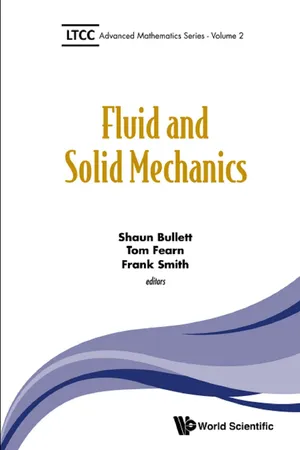
- 228 pages
- English
- ePUB (mobile friendly)
- Available on iOS & Android
Fluid and Solid Mechanics
About this book
This book leads readers from a basic foundation to an advanced-level understanding of fluid and solid mechanics. Perfect for graduate or PhD mathematical-science students looking for help in understanding the fundamentals of the topic, it also explores more specific areas such as multi-deck theory, time-mean turbulent shear flows, non-linear free surface flows, and internal fluid dynamics.
Fluid and Solid Mechanics is the second volume of the LTCC Advanced Mathematics Series. This series is the first to provide advanced introductions to mathematical science topics to advanced students of mathematics. Edited by the three joint heads of the London Taught Course Centre for PhD Students in the Mathematical Sciences (LTCC), each book supports readers in broadening their mathematical knowledge outside of their immediate research disciplines while also covering specialized key areas.
Contents:
- Introductory Geophysical Fluid Dynamics (Michael Davey)
- Multiple Deck Theory (S N Timoshin)
- Time-Mean Turbulent Shear Flows: Classical Modelling — Asymptotic Analysis — New Perspectives (Bernhard Scheichl)
- Nonlinear Free Surface Flows with Gravity and Surface Tension (J-M Vanden-Broeck)
- Internal Fluid Dynamics (Frank T Smith)
- Fundamentals of Physiological Solid Mechanics (N C Ovenden and C L Walsh)
Readership: Researchers, graduate or PhD mathematical-science students who require a reference book that covers fluid dynamics and solid mechanics.
Pure Mathematics;Applied Mathematics;Mathematical Sciences;Techniques;Algebra;Logic;Combinatorics;Fluid Dynamics;Solid Mechanics Key Features:
- Each chapter is written by a leading lecturer in the field
- Concise and versatile
- Can be used as a masters level teaching support or a reference handbook for researchers
Frequently asked questions
- Essential is ideal for learners and professionals who enjoy exploring a wide range of subjects. Access the Essential Library with 800,000+ trusted titles and best-sellers across business, personal growth, and the humanities. Includes unlimited reading time and Standard Read Aloud voice.
- Complete: Perfect for advanced learners and researchers needing full, unrestricted access. Unlock 1.4M+ books across hundreds of subjects, including academic and specialized titles. The Complete Plan also includes advanced features like Premium Read Aloud and Research Assistant.
Please note we cannot support devices running on iOS 13 and Android 7 or earlier. Learn more about using the app.
Information
Chapter 1
Introductory Geophysical Fluid Dynamics
University of Cambridge, Centre for Mathematical Sciences,
Wilberforce Road, Cambridge CB3 0WA, UK
[email protected]
1.Introduction
2.Governing Equations

Table of contents
- Cover
- Title
- Copyright
- Preface
- Contents
- 1. Introductory Geophysical Fluid Dynamics
- 2. Multiple Deck Theory
- 3. Time-Mean Turbulent Shear Flows: Classical Modelling — Asymptotic Analysis — New Perspectives
- 4. Nonlinear Free Surface Flows with Gravity and Surface Tension
- 5. Internal Fluid Dynamics
- 6. Fundamentals of Physiological Solid Mechanics